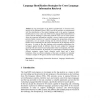111
Voted
CLEF
2010
Springer
15 years 1 months ago
2010
Springer
This paper describes the participation of the Bioingenium Research Group in the ad hoc Medical Image Retrieval task for the 2010 ImageCLEF forum. The work aimed to explore semantic...
112
click to vote
CLEF
2010
Springer
15 years 1 months ago
2010
Springer
In our participation to the 2010 LogCLEF track we focused on the analysis of the European Library (TEL) logs and in particular we experimented with the identification of the natura...
121
Voted
CLEF
2010
Springer
15 years 1 months ago
2010
Springer
Wikipedia describes itself as the "free encyclopedia that anyone can edit". Along with the helpful volunteers who contribute by improving the articles, a great number of ...
115
Voted
CLEF
2010
Springer
15 years 1 months ago
2010
Springer
The challenges of searching the increasingly large collections of digital images which are appearing in many places mean that automated annotation of images is becoming an importan...
97
Voted
CLEF
2010
Springer
15 years 1 months ago
2010
Springer
Ambiguities in company names are omnipresent. This is not accidental, companies deliberately chose ambiguous brand names, as part of their marketing and branding strategy. This pro...
118
Voted
CLEF
2010
Springer
15 years 1 months ago
2010
Springer
This paper summarizes the results of our first participation at ResPubliQA. Lacking a true question answering system, we relied on our traditional search engine to find the answers...
CLEF
2010
Springer
15 years 1 months ago
2010
Springer
This paper describes the robot vision track that has been proposed to the ImageCLEF 2010 participants. The track addressed the problem of visual place classification, with a specia...
111
Voted
CLEF
2010
Springer
15 years 1 months ago
2010
Springer
This paper presents the UESTC contribution to the ImageCLEF 2010 medical retrieval task. For ad-hoc retrieval and case-based retrieval, we only use text information, and propose a ...
CLEF
2010
Springer
15 years 1 months ago
2010
Springer
We report on our approaches and methods for the ImageCLEF 2010 Wikipedia image retrieval task. A distinctive feature of this year's image collection is that images are associ...
75
Voted
CLEF
2010
Springer
15 years 1 months ago
2010
Springer
In this paper, we describe the algorithm that has been used to carry out our plagiarism detection within the context of PAN10 competition. Our system is based on the LempelZiv dist...


